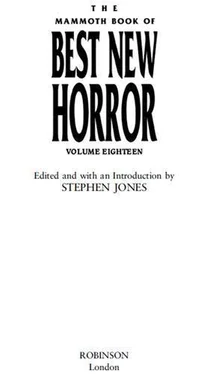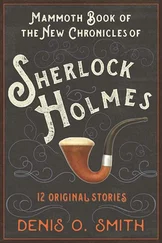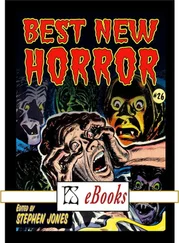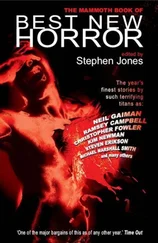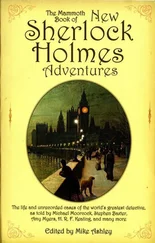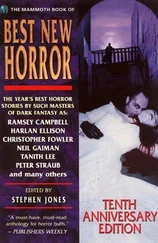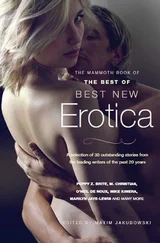Stephen (ed.) - The Mammoth Book of Best New Horror 18
Здесь есть возможность читать онлайн «Stephen (ed.) - The Mammoth Book of Best New Horror 18» весь текст электронной книги совершенно бесплатно (целиком полную версию без сокращений). В некоторых случаях можно слушать аудио, скачать через торрент в формате fb2 и присутствует краткое содержание. Жанр: Старинная литература, на английском языке. Описание произведения, (предисловие) а так же отзывы посетителей доступны на портале библиотеки ЛибКат.
- Название:The Mammoth Book of Best New Horror 18
- Автор:
- Жанр:
- Год:неизвестен
- ISBN:нет данных
- Рейтинг книги:3 / 5. Голосов: 1
-
Избранное:Добавить в избранное
- Отзывы:
-
Ваша оценка:
- 60
- 1
- 2
- 3
- 4
- 5
The Mammoth Book of Best New Horror 18: краткое содержание, описание и аннотация
Предлагаем к чтению аннотацию, описание, краткое содержание или предисловие (зависит от того, что написал сам автор книги «The Mammoth Book of Best New Horror 18»). Если вы не нашли необходимую информацию о книге — напишите в комментариях, мы постараемся отыскать её.
The Mammoth Book of Best New Horror 18 — читать онлайн бесплатно полную книгу (весь текст) целиком
Ниже представлен текст книги, разбитый по страницам. Система сохранения места последней прочитанной страницы, позволяет с удобством читать онлайн бесплатно книгу «The Mammoth Book of Best New Horror 18», без необходимости каждый раз заново искать на чём Вы остановились. Поставьте закладку, и сможете в любой момент перейти на страницу, на которой закончили чтение.
Интервал:
Закладка:
Doug would never forget Rochelle’s face, either. He had gotten to play the role of father to her for about a week and change, and it had scarred him indelibly. Given time, her loss, too, was a strangely welcome kind of pain.
Legally, disinterment was a touchy process, since the casket containing the remains was supposed to be technically “undamaged” when removed from the earth. This meant Jacky and the other backhoe operators could only skim to a certain depth – the big scoops – before Doug or one of his co-workers had to jump in with a shovel. Some of the big concrete grave liners were stacked three deep to a plot; at least, Craignotti had said something about three being the limit. They looked like big, featureless refrigerators laid on end, and tended to crumble like plaster. Inside were the burial caskets. Funeral publicists had stopped calling them coffins about forty years ago. “Coffins” were boxes shaped to the human form, wide at the top, slim at the bottom, with the crown shaped like the top half of a hexagon. “Coffins” evoked morbid assumptions, and so were replaced in the vernacular with “caskets” – nice, straight angles, with no Dracula or Boot Hill associations. In much the same fashion, “cemeteries” had become “memorial parks”. People did everything they could, it seemed, to deny the reality of death.
Which explained the grave liners. Interment in coffins, caskets, or anything else from a wax-coated cardboard box to a shroud generally left a concavity in the lawn, once the body began to decompose, and its container, to collapse. In the manner of a big, mass-produced, cheap sarcophagus, the concrete grave liners prevented the depressing sight of . . . er, depressions. Doug imagined them to be manufactured by the same place that turned out highway divider berms; the damned things weighed about the same.
Manning his shovel, Doug learned a few more firsthand things about graves. Like how it could take eight hours for a single digger, working alone, to excavate a plot to the proper dimensions. Which was why Craignotti had been forced to locate operators for no fewer than three backhoes on this job. Plus seven “scoopers” in Doug’s range of ability. The first shift, they only cleared 50 final resting places. From then on, they would aim for a hundred stiffs per working day.
Working. Stiffs . Rampant, were the opportunities for gallows humor.
Headstones were stacked as names were checked off the master list. BEECHER, LEE, 1974–2002 – HE PROTECTED AND SERVED. GUDGELL, CONROY, 1938–2003 – DO NOT GO GENTLY. These were newer plots, more recent deaths. These were people who cared about things like national holidays or presidential elections, archetypal Americans from fly-over country. But in their midst, Doug was also a cliché – the drifter, the stranger. If the good folk of Triple Pines (the living ones, that is) sensed discord in their numbers, they would actively seek out mutants to scotch. Not One of Us.
He had to get out. Just this job, just a few days, and he could escape. It was better than being a mutant, and perhaps getting lynched. He moved on to STOWE, DORMAND R., 1940–1998 — LOVING HUSBAND, CARING FATHER. Not so recent. Doug felt a little bit better.
They broke after sunset. That was when Doug back-checked the dig list and found a large, red X next to Michelle Farrier’s name.
“This job ain’t so damned secret,” said Joe Hopkins, later, at Callahan’s. Their after-work table was five: Joe, Jacky, Doug, and two more guys from the shift, Miguel Ayala and Boyd Cooper. Craignotti sat away from them, at his accustomed roost near the end of the bar. The men were working on their third pitcher. Doug found that no amount of beer could get the taste of grave dirt out of the back of his throat. Tomorrow, he’d wear a bandana. Maybe .
“You working tomorrow, or not, or what?” said Craignotti. Doug gave him an if-come answer, and mentioned the bandana. Craignotti had shrugged. In that moment, it all seemed pretty optional, so Doug concentrated on becoming mildly drunk with a few of the crew working the – heh – graveyard shift.
Joe was a musclebound ex-biker type who always wore a leather vest and was rarely seen without a toothpick jutting from one corner of his mouth. He had cultivated elaborate moustaches which he waxed. He was going grey at the temples. His eyes were dark, putting Doug in mind of a gypsy. He continued: “What I mean is, nobody’s supposed to know about this little relocation. But the guys in here know, even if they don’t talk about it. The guys who run the Triple Pines bank sure as shit know. It’s a public secret. Nobody talks about it, is all.”
“I bet the mayor’s in on it, too,” said Miguel. “All in, who cares? I mean, I had to pick mushrooms once for a buck a day. This sure beats the shit out of that.”
“Doesn’t bother you?” said Boyd Cooper, another of the backhoe jockeys. Older, pattern baldness, big but not heavy. Bull neck and cleft chin. His hands had seen a lifetime of manual labor. It had been Boyd who showed them how to cable the lids off the heavy stone grave liners, instead of bringing in the crane rig used to emplace them originally. This group’s unity as mutual outcasts gave them a basic common language, and Boyd always cut to the gristle. “Digging up dead people?”
“Nahh,” said Jacky, tipping his beer. “We’re doing them a favor. Just a kind of courtesy thing. Moving ’em so they won’t be forgotten.”
“I guess,” said Joe, working his toothpick. He burnished his teeth a lot with it. Doug noticed one end was stained with a speck of blood, from his gums.
“You’re the teacher,” Boyd said to Doug. “You tell us. Good thing or bad thing?”
Doug did not want to play arbiter. “Just a job of work. Like resorting old files. You notice how virtually no one in Triple Pines got cremated? They were all buried. That’s old-fashioned, but you have to respect the dead. Laws and traditions.”
“And the point is . . . ?” Boyd was looking for validation.
“Well, not everybody is entitled to a piece of property when they die, six by three by seven. That’s too much space. Eventually we’re going to run out of room for all our dead people. Most plots in most cemeteries are rented, and there’s a cap on the time limit, and if somebody doesn’t pay up, they get mulched. End of story.”
“Wow, is that true?” said Jacky. “I thought you got buried, it was like, forever.”
“Stopped being that way about a hundred years ago,” said Doug. “Land is worth too much. You don’t process the dead and let them use up your real estate without turning a profit.”
Miguel said, “That would be un-American.” He tried for a chuckle but it died.
“Check it out if you don’t believe me,” said Doug. “Look it up. Behind all that patriotic rah-rah-rah about community brotherhood and peaceful gardens, it’s all about capital gains. Most people don’t like to think about funerals or cemeteries because, to them, it’s morbid. That leaves funeral directors free to profiteer.”
“You mean Coggins?” said Joe, giving himself a refill.
“Look, Coggins is a great example,” said Doug. “In the outside world, big companies have incorporated most aspects of the funeral. Here, Coggins runs the mortuary, the cemetery, everything. He can charge whatever he wants, and people will pay for the privilege of shunting their grief and confusion onto him. You wouldn’t believe the markup on some of this stuff. Caskets are three times wholesale. Even if they put you in a cardboard box – which is called an ‘alternative container’, by the way – the charge is a couple of hundred bucks.”
“Okay, that settles it,” said Miguel. When he smiled big, you could see his gold tooth. “We all get to live forever, because we can’t afford to die.”
Читать дальшеИнтервал:
Закладка:
Похожие книги на «The Mammoth Book of Best New Horror 18»
Представляем Вашему вниманию похожие книги на «The Mammoth Book of Best New Horror 18» списком для выбора. Мы отобрали схожую по названию и смыслу литературу в надежде предоставить читателям больше вариантов отыскать новые, интересные, ещё непрочитанные произведения.
Обсуждение, отзывы о книге «The Mammoth Book of Best New Horror 18» и просто собственные мнения читателей. Оставьте ваши комментарии, напишите, что Вы думаете о произведении, его смысле или главных героях. Укажите что конкретно понравилось, а что нет, и почему Вы так считаете.
